There is a never-ending flow of great ideas for digital products floating in the technology world at any given time. Whether it’s the next home run app ready to disrupt the industry or it’s a powerful commerce play that will virally reach millions of eyeballs, your idea will hopefully be the one to catch fire. With an engaging foundation, some good timing, and bit of luck your concept just might be.
Or it may not be.
It might just be the one that boasts great design, a powerful technical infrastructure, and a catchy hook… but can’t find an audience. It might be the one that sparks the dreams and imagination of future generation, but isn’t currently supported on mobile. It might be the one that just didn’t have the right team writing the code and ended up in a state of limbo.
The Wonderment team thinks about this juxtaposition on a daily basis. As a digital design and development agency, we regularly connect with entrepreneurs, business leads, and creative minds to evaluate a wide array of potential project. We meet with the amazing folks that have that next great concept and just need to know what it’s going to take to pull it off… they need to know how much it will cost and how long it will take to build. We meet with people ready to put their soul into creating a business that will inspire the masses and touch the individual.
And the dreams are always big! …But big dreams can come at a cost.
BIG DREAMS
In many cases, when a business owner hears the actual price tag of an idea’s execution they (often for the first time) realize the amount of effort and dedication that is actually required to bring every bell and whistle to life. And, in many cases, they are shocked by the cost because they haven’t yet taken the time to assess the actual value of the concepts they came up with. And early in the process, they may not even know if there is a real audience out there for it.
Figure out if there is an actual need?
This is usually the first question that should be asked. Every great innovation comes from assessing the market. A simple method we like to start with begins with answering the following question – “What does my website or app do to help people?” At the very core of the product, what problem is it helping to solve? Ideally you are able to get pretty specific. An example of a great answer might be: “My app helps people communicate more efficiently by sending alert notifications across all devices at the same moment – no matter the platform.”
THE COMPETITIVE LANDSCAPE
As soon as you have this answer, I start with a simple Google Search… in the case above, I might use the concept “app notifications”. After running a search for “app notification” I discover a handful of potential competitors – the strongest of which appears to be “Pushbullet”, an Android-based notification system.
To get an idea of the market competition, I primarily assess if there are any players in the space buying ads. While this is not a formally solidified measurement of competition, it does give you insight on people that are spending money in the space and actively looking to attract an audience. If there are no ads, then the organic search results are the next best place to look. These results tell us which companies are ranking in Google’s algorithm – usually because they have taken the time and effort to optimize their results.
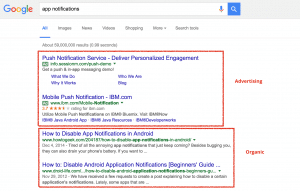
The top results show current spenders. These may rotate so multiple searches across time horizons may be valuable.
App Annie is another great resource in the mobile app space. With App Annie, you can get current and historical charting data from the app stores. These are broken down based on category, company, and monetization type. Another great tool that tends to be very useful is ‘Keyword Ranks’. Similar to Google, you can search for specific keywords to locate chart performers. Additionally signing up for their Premium Insights service can allow you to delve deeper into the data and answer more granular questions.
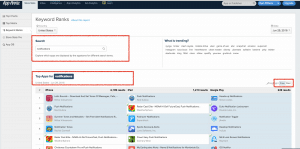
App Annie allows you to use store chart data to determine specific audience performance information.
From these results we can get an initial list of competitors and actually go study their offerings. At that point you are able to assess if a) you are up against an existing concept, or if you have a unique take on the approach that people haven’t yet latched onto.
ASSESSING AUDIENCE SIZE
After studying some of the key competitor offerings and recognizing that there is enough demand to warrant one or two similar companies, I jump over to one of several great ad platforms that can provide a quick assessment how much potential audience there is:
Facebook Ads
The Facebook Ads platform offers a robust way to dive into audience segmentation. This powerful tool allows you to think about who you’re key audiences might be and quantify a rough assessment on its size. To start using the tool you simply need to set up a Facebook page representing your product or business. Once that’s in place, you can go into the Facebook ads manager and begin creating your first ad.
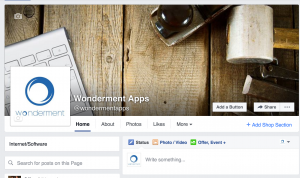
It’s during this ad creation process that you will see audience targeting options which include geo location, gender, age range, and other standard demographic options. The real magic however comes when you tap into the psychographic toolsets that deliver interests and behaviors.
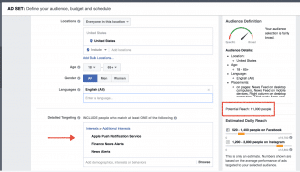
Sample of Facebook Ad creation process for ROI
By selecting these options you can see audience sizes as they relate to profile sense that may show genuine interest in your product and service. Simply choose your audience targeting options and watch Facebook estimate the audience size on the right hand column. To choose the best options, you’ll want to consider audiences in as granular of a sense as possible. For consumer apps, you might look at audiences with interests in commiserate brands or products using gender and age as powerful drivers. However, for enterprise apps, you might apply industry and job type logic to narrow down to users that are actual potential purchasers.
Google Keywords
Another great option for assessing audience size is to look at sentiment based targeting. While Google Adwords is primarily developed for advertising, it offers a great way to get general search volume on concepts. This search volume helps tell me if there is actual sentiment for the variation on the concept I’m putting forward. Using a the existing sites I pulled insight from, I can develop a short-list of keywords that may have relevant search content.
With Google Adwords, you might go into the keyword planner tool, provide basic targeting data such as geo location and language to generate keyword search estimates.
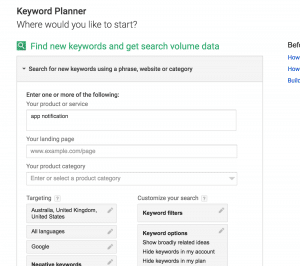
Using Google AdWords Keyword Planner to search for Audience size
This is powerful because it gives you an idea of the amount of people that are actually looking for terms across the Internet that may relate to potential purchasing of your product or service. This sentiment analysis is a very clear marker of people that are actually in need of the product or service or a related product or service that you were offering. Unlike Facebook, this will not provide actual audience size, rather search volume that can relate to direct need or desire for usage of the product or service.
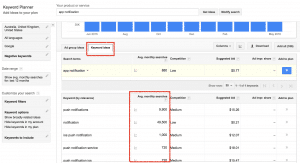
Estimated Search Volume for a series of keywords relevant to your product.
—-
After determining the potential competitors and audience scope, you are set to take the analysis of your concept a bit further. In the next article, we look at quick ways to measure ROI estimates and figure out if the potential value of your idea can be unlocked.

Trackbacks/Pingbacks